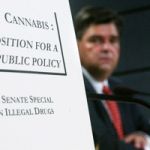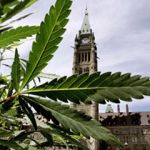25 states call marijuana 'medicine.' But marijuana again failed an analysis conducted by the FDA and NIDA. The FDA concluded that medical and scientific data do not yet prove that marijuana is safe and effective as a medicine.
To Your Health
U.S. affirms its prohibition on medical marijuana
By Lenny Bernstein
To Your Health
August 11 at 11:00 AM
Lenny Bernstein covers health and medicine. He started as an editor on the Post’s National Desk in 2000 and has worked in Metro and Sports. Follow @LennyMBernstein
This post has been updated.
The government refused again Thursday to allow the use of marijuana for medical purposes, reaffirming its conclusion that the drug’s therapeutic value has not been proved scientifically and defying a growing clamor to legalize it for the treatment of a variety of conditions.
In an announcement in the Federal Register and a letter to petitioners, the Drug Enforcement Administration turned down requests to remove marijuana from “Schedule I,” which classifies it as a drug with “no currently accepted medical use” in the United States and precludes doctors from prescribing it.
The decision keeps the federal government at odds with 25 states and the District of Columbia, which have passed laws allowing medical use of marijuana to some degree. Members of Congress have called for its reclassification and on Wednesday, the National Conference of State Legislatures adopted a resolution asking the federal government to remove marijuana from Schedule I.
"Right now, the science doesn't support it," Chuck Rosenberg, acting administrator of the Drug Enforcement Administration, said in an interview Thursday. Citing a lengthy analysis conducted by the Food and Drug Administration, he said the decision "is tethered to the science."
The agency announced one policy change that could increase the amount of research conducted on marijuana: the DEA will expand the number of places allowed to grow marijuana for studies of its value in chronic pain relief, as a treatment for epilepsy and for other purposes. Currently, only the University of Mississippi,which holds an exclusive contract with the National Institute on Drug Abuse, is federally licensed to grow marijuana for research purposes.
The latest development in the 46-year legal and policy battle over the status of marijuana disappointed advocates of looser restrictions on the drug, who had hoped that the government would carve out a special place for marijuana in the controlled-substance regulations or move it to a less tightly regulated category, Schedule II.
[25 states call marijuana 'medicine.' Why doesn't the DEA?]
In the words of a 2015 Brookings Institution report, a move to Schedule II “would signal to the medical community that [the Food and Drug Administration and the National Institutes of Health] are ready to take medical marijuana research seriously, and help overcome a government-sponsored chilling effect on research that manifests in direct and indirect ways.”
But as it has in previous reviews, marijuana again failed an analysis conducted by the FDA and NIDA. The FDA concluded that medical and scientific data do not yet prove that marijuana is safe and effective as a medicine. Legally, that prohibits the DEA from reclassifying the drug.
“We’re pleased to see that the Obama Administration … understands the science the way we and almost every single medical association in the country understand it,” said Kevin Sabet, president of Smart Approaches to Marijuana, which opposes loosening restrictions on marijuana.
Rep. Earl Blumenauer (D-Ore.) praised the decision to allow more facilities to cultivate marijuana for research, but said the decision doesn’t go far enough. “This decision ... is further evidence that the DEA doesn’t get it. Keeping marijuana at Schedule I continues an outdated, failed approach — leaving patients and marijuana businesses trapped between state and federal laws,” Blumenauer said.
Schedule I drugs — which include LSD and heroin, as well as marijuana — have “no currently accepted medical use in the United States, a lack of accepted safety for use under medical supervision, and a high potential for abuse.” Schedule II drugs, such as the powerful narcotic painkillers that have caused an epidemic of addiction over the past decade, have medicinal value but “a high potential for abuse which may lead to severe psychological or physical dependence.” Marijuana was placed in Schedule I in 1970, when Congress passed the Controlled Substances Act.
[Brookings says government is stifling medical marijuana research]
Research has shown that some components of marijuana have promise as a treatment for epilepsy and chronic pain. Some people use it to relieve the symptoms of post-traumatic stress disorder, although research has not been conducted to prove its value for that condition.
Rosenberg said that while individual researchers may have shown that marijuana or its extracts are helpful for certain conditions, the FDA has the most comprehensive view of the state of scientific research on the drug.
"The FDA knows this better than anyone on the planet," he said, though he acknowledged that "a lot of people will disagree with that."
He also noted that many people misconstrue the controlled substance scheduling regime as a ranking of drugs' relative dangers. Clearly, he said, marijuana is not as dangerous as heroin, LSD and perhaps some of the opioids in Schedule 2. "It's not the Richter Scale," he said. But that doesn't mean cannabis and its extracts are safe for medical use and not prone to abuse, he added.
Academic researchers have complained that registration and application requirements to work with Schedule I drugs make studying their purported benefits difficult. The DEA, however, says the number of researchers registered to study marijuana and its components has doubled in the past two years.
The governors of Rhode Island and Washington, and a New Mexico resident, Bryan A. Krumm, petitioned the DEA to remove marijuana from Schedule I. The agency most recently rejected a similar request in 2011, touching off a legal battle to force reclassification in which the DEA ultimately prevailed.
With so many states allowing the use of cannabis components for health reasons, Rosenberg acknowledged the conflict with the federal government's posture. But he said prescribers need not fear that the announcement signals a federal crackdown.
"We are not changing our enforcement priorities," he said.
It is unclear how many more facilities would be allowed to grow marijuana for researchers under the new rules. But the government signaled its intent to end the effective monopoly on cultivation maintained by NIDA and the University of Mississippi, officials said. That would allow a greater supply and a wider variety of products for research. Growers would apply to DEA, not NIDA, for permission to cultivate.
"If petitioners meet our criteria, and they can assure us that this stuff can be handled safely and securely," they likely will be given permission to cultivate marijuana for research purposes, he said.
[Drug derived from cannabis shows promise for children with epilepsy]
The new policy also contains a “statement of principles” that reminds growers of the provisions of a 2014 law that governs the use of industrial hemp. The plant is a cannabis variant that contains a low concentration of tetrahydrocannabinol, or THC, the chemical responsible for most of marijuana’s impact on the brain.
Christopher Ingraham contributed to this report.
Christopher Ingraham writes about politics, drug policy and all things data. He previously worked at the Brookings Institution and the Pew Research Center.
Follow @_cingraham
https://www.washingtonpost.com/news/wonk/wp/2016/08/11/the-deas-latest-s...
Wonkblog
Why the DEA just said ‘no’ to loosening marijuana restrictions
By Christopher Ingraham
Wonkblog
August 11 at 10:37 AM
For the fourth consecutive time, the Drug Enforcement Administration has denied a petition to lessen federal restrictions on the use of marijuana.
While recreational marijuana use is legal in four states and D.C., and medical applications of the drug have been approved in many more, under federal law, it remains a Schedule 1 controlled substance, which means it's considered to have "no currently accepted medical use" and a "high potential for abuse."
The gap between permissive state laws and a restrictive federal policy has become increasingly untenable in the minds of many doctors, patients, researchers, business owners and legislators.
For instance, last fall, a Brookings Institution report slammed the federal government for "stifling medical research" in the area of marijuana policy. As a Schedule 1 drug, it's much harder for researchers to work with marijuana than with many other controlled substances. The American Academy of Pediatrics has called on the government to move marijuana into Schedule 2 to facilitate more research into medical uses.
The current federal status of marijuana makes it impossible for state-legal marijuana businesses to take the same tax deductions afforded to other business, with some marijuana operations complaining that their effective tax rates are in the range of 60 percent to 90 percent, according to a Denver accountant who works with such businesses, Jordan Cornelius. Federal restrictions also make banks reluctant to work with marijuana businesses, leading many of them to become all-cash operations — with all the risks that entails.
[U.S. will affirm its prohibition on medical marijuana]
Just this week, the National Conference of State Legislatures, a group representing state lawmakers, called on the federal government to move marijuana from Schedule 1 to Schedule 2. The group criticized federal law for imposing "substantial administrative and operational burdens, compliance risk and regulatory risk that serve as a barrier to banks and credit unions providing banking services to businesses and individuals involved in the cannabis industry."
Despite these concerns, the DEA today denied the petition, initiated by then-governors Lincoln Chafee of Rhode Island and Christine Gregoire of Washington state in 2011, to loosen restrictions on the drug. In a letter to the petitioners, acting DEA Administrator Chuck Rosenberg explained the agency's ruling and offered a full-throated defense of federal marijuana policy.
"The FDA drug approval process for evaluating potential medicines has worked effectively in this country for more than 50 years," he wrote. "It is a thorough, deliberate and exacting process grounded in science, and properly so, because the safety of our citizens relies on it."
Rosenberg went on to point out that according to the Food and Drug Administration, marijuana "does not have a currently accepted medical use in treatment in the United States."
From a strictly legal standpoint, this is correct. The FDA has never approved whole-plant marijuana as a drug. It's also unlikely to do so, since most drugs the FDA approves of are individual chemical compounds, not plants.
Penicillin is an FDA-approved drug, for instance. The mold it's derived from is not.
"If the scientific understanding about marijuana changes — and it could change — then the decision could change," Rosenberg wrote. "But we will remain tethered to science, as we must, and as the statute demands."
[What Congress is saying about the DEA’s refusal to change course on pot]
Rosenberg also pointed out that marijuana's schedule status isn't a function of the relative "danger" posed by the drug. He explicitly wrote that marijuana is "less dangerous than some substances in other schedules" -- a departure from the official line held as recently as last year.
"That strikes some people as odd, but the criteria for inclusion in Schedule 1 is not relative danger," he wrote. Rather, it lies primarily with the medical designations discussed above.
As the nation's top drug cop, Rosenberg's close, by-the-letter reading of the law makes sense. But it overlooks a wide range of research showing that marijuana, in whole plant form, can be effective at treating a wide array of ailments — chronic pain chief among them. This research is a major reason many states have gone ahead with their own medical marijuana policies in defiance of the federal government.
Doctors generally say that they support giving marijuana to patients if it provides them relief from serious conditions. Many state legislatures — not wanting to stand between doctors and their patients — have enacted state legal frameworks allowing them to do so.
Despite this, the DEA says it cannot change the legal status of marijuana unless the FDA determines it has a medical use. The FDA cannot determine it has a medical use in part because of the highly restrictive legal status of the drug. It's a classic bureaucratic Catch-22.
The only body that can truly resolve this conflict, now, is Congress — by amending the Controlled Substances Act to treat marijuana differently. Most federal lawmakers seem to agree that this needs to happen, but there's disagreement on how to do it.
More conservative approaches — championed even by some of Congress's most strident opponents of marijuana legalization, like Maryland's Rep. Andy Harris (R) -- would create a special carve-out for marijuana within Schedule 1. This would include a number of provisions making it easier for researchers to work with the drug.
Another bill in the Senate would explicitly move marijuana to Schedule 2. Still other lawmakers — Sen. Bernie Sanders (Vt.) most prominent among them — are calling for marijuana to be removed from the Controlled Substances Act completely.
All of this is happening as a number of states — including California, Massachusetts, Nevada and Arizona — will vote on whether to legalize recreational marijuana this fall. If they do so, the gap between state and federal marijuana policy will grow even larger, creating even more confusion and headaches for the doctors, patients, researchers and businesses trying to thread the needle between the two.















Add new comment